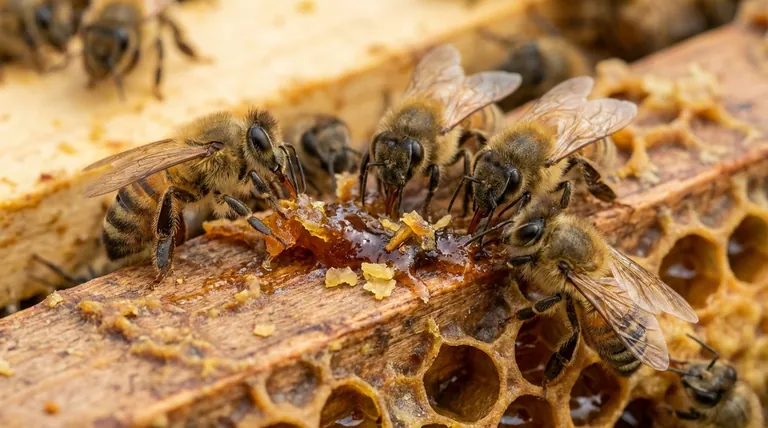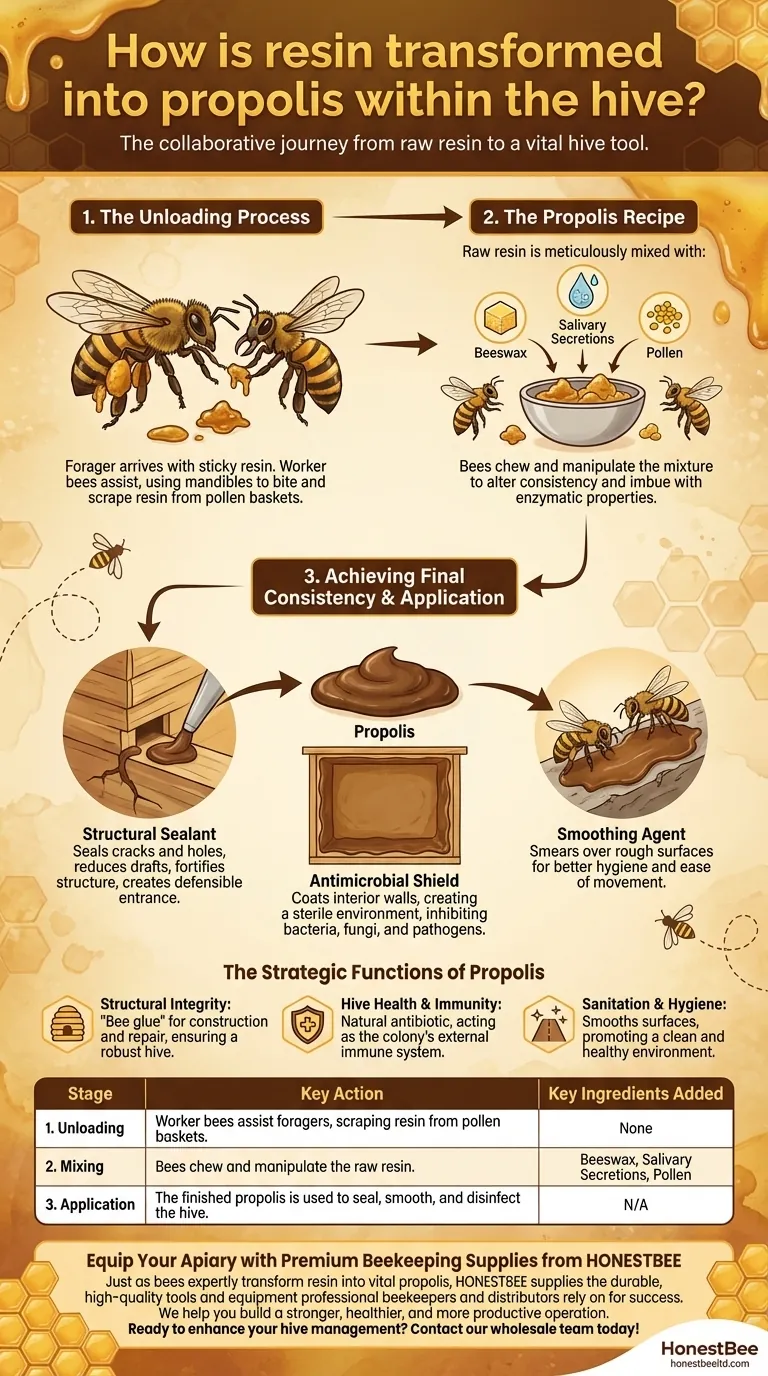The transformation of resin into propolis is a collaborative, multi-step process inside the hive. Arriving forager bees require assistance from other worker bees, who bite the raw, sticky resin off their pollen baskets. This raw material is then meticulously mixed with beeswax, salivary secretions, and a small amount of pollen to create the final propolis.
Propolis is not merely collected resin; it is a manufactured substance. Bees intentionally blend raw plant resins with their own biological materials to create a versatile compound essential for both the structural integrity and the immunological defense of the entire colony.

The Journey from Raw Resin to Finished Propolis
The creation of propolis begins the moment a forager bee returns to the hive with her valuable, sticky cargo. The process is a testament to the efficiency and collaborative nature of the honeybee colony.
The Unloading Process
Upon arrival, the forager bee cannot unload the sticky resin by herself.
Other worker bees must assist, using their mandibles (mouthparts) to carefully bite and scrape the resin from the forager's rear legs, specifically from the structures known as corbiculae or pollen baskets.
The Propolis Recipe
Once unloaded, the raw resin is not yet propolis. The bees act as master pharmacists, transforming it by adding specific ingredients.
The primary additives are beeswax and salivary secretions. These components alter the resin's consistency and imbue it with enzymatic properties. A small amount of pollen is also mixed in.
Achieving the Final Consistency
The worker bees chew and manipulate this mixture. This mechanical and chemical processing continues until the propolis achieves the desired texture and malleability for its intended use within the hive.
The Strategic Functions of Propolis
Bees produce propolis on an as-needed basis to solve specific problems. It is not stored long-term like honey or pollen, but rather serves as a dynamic, multi-purpose tool.
A Structural Sealant
Propolis is often called "bee glue" for its powerful adhesive properties. Bees use it to seal cracks and holes, reducing drafts and fortifying the hive's structure against the elements and predators.
It's also used to reduce the size of the hive entrance, creating a more defensible chokepoint against intruders.
An Antimicrobial Shield
Beyond its structural role, propolis is a cornerstone of hive health. It functions as the colony's external immune system, providing a natural antibiotic and antimicrobial defense.
Bees coat the interior walls and surfaces with a thin layer of propolis. This creates a sterile environment that inhibits the growth of bacteria, fungi, and other pathogens, helping the colony fight off infection and disease.
A Smoothing Agent
Bees also use propolis to smear over rough surfaces within the hive. This creates smooth, clean pathways that improve hygiene and ease of movement for the thousands of inhabitants.
Making the Right Choice for Your Goal
Understanding propolis is understanding the ingenuity of the honeybee colony. They transform a simple raw material into a sophisticated tool for construction, sanitation, and defense.
- If your primary focus is hive structure: Recognize that propolis is the bee's essential tool for construction, repair, and waterproofing.
- If your primary focus is hive health: Understand that propolis is a vital part of the colony's "social immunity," acting as a built-in pharmacy.
Ultimately, propolis demonstrates how bees actively engineer their environment to ensure their collective survival.
Summary Table:
| Stage | Key Action | Key Ingredients Added |
|---|---|---|
| 1. Unloading | Worker bees assist foragers, scraping resin from pollen baskets. | None |
| 2. Mixing | Bees chew and manipulate the raw resin. | Beeswax, Salivary Secretions, Pollen |
| 3. Application | The finished propolis is used to seal, smooth, and disinfect the hive. | N/A |
Equip Your Apiary with Premium Beekeeping Supplies from HONESTBEE
Just as bees expertly transform resin into vital propolis, your commercial operation or distribution business needs the right tools for success. HONESTBEE supplies the durable, high-quality beekeeping supplies and equipment that professional beekeepers and distributors rely on.
We help you build a stronger, healthier, and more productive operation.
Ready to enhance your hive management? Contact our wholesale team today to discuss your needs and explore our product catalog.
Visual Guide

Related Products
- Plastic Handle Single Row Artificial Fiber Bee Brush
- Wooden Queen Bee Excluder for Beekeeping
- Professional Plastic Queen Excluder for Modern Beekeeping
- Mesh Ventilated 3 Layer Goatskin Beekeepers Gloves for Beekeeping
- Professional Insulated Winter Hive Wrap for Beekeeping
People Also Ask
- What is the function of a bee brush in beekeeping? Master Gentle Bee Handling for Hive Success
- How is a bee brush used in beekeeping? Master Gentle Bee Handling for Your Apiary
- What is the primary use of a bee brush during inspections and extraction? Essential for Gentle Bee Handling
- What are the characteristics of a bee brush's bristles and handle? Gentle Tools for Healthy Hives
- What are the key features of a popular bee brush? Essential Design for Bee Safety and Hive Hygiene



















